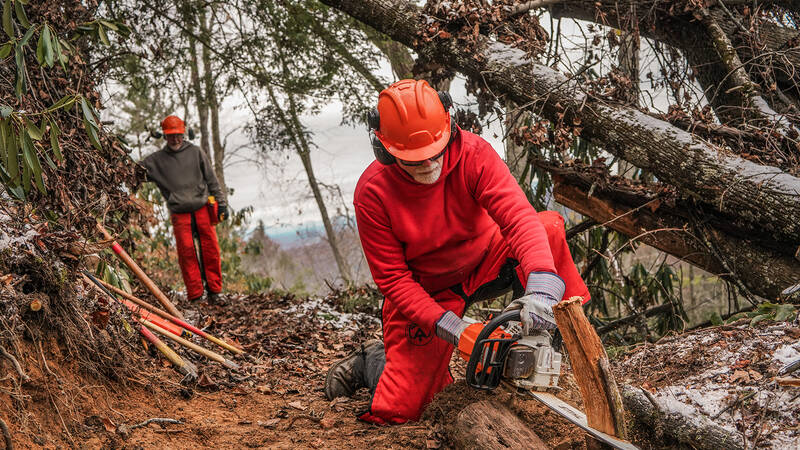Recovery is underway at national park sites hit hard by Hurricane Helene in September 2024. We offer updates as visitors consider spring and summer travel.
Appalachian National Scenic Trail
Roughly 800 miles of the Appalachian Trail were impacted after Hurricane Helene, and over 430 miles of the trail had to be closed. As of this month, only about five miles remained closed by the U.S. Forest Service due to damage along the Tennessee/Virginia border, thanks to clearing work by the Appalachian Trail Conservancy (ATC), volunteers, donors and local trail clubs. A temporary detour has been routed through that area.
Trail conditions change daily, so hikers are encouraged check the Appalachian Trail Conservancy’s website.

A crew clears a portion of the Appalachian National Historic Trail in December 2024.
Appalachian Trail Conservancy/Tyler IrvingRecovery work is expected to take years to complete, and the ecological impacts from the damage also loom large, according to the ATC.
“On many of the sections that have reopened, repairs are still needed on the treadway where trees were ripped out by the roots. Some parts of the footpath are ‘punched through,’ meaning that you can hike it, but the damage is still extensive surrounding the Trail,” Communications Director Ann Simonelli said in an email.
More recent winds and storms continue to cause damage in compromised areas, so hikers are encouraged to stay aware of their surroundings and weather conditions when hiking impacted areas.
Forest health and the hiker experience along the trail could be affected for years to come because of the increased risk of wildfires and landslides from so many uprooted and damaged trees, as well as a greater threat of disease and encroachment of non-native invasive species into rare and threatened habitats, Simonelli said.
Blue Ridge Parkway
The Blue Ridge Parkway sustained significant damage, with countless downed trees and at least 57 landslides in various sizes identified across approximately 200 miles in North Carolina. Both the Virginia and North Carolina sections of the parkway experienced widespread treefall, erosion and trail and culvert damage, as well as impaired historic structures and critical public infrastructure.
The highest concentration of overall roadway and infrastructure damage occurred from North Carolina’s Linville Falls area, near milepost 317, south to Mount Mitchell State Park, near milepost 349.
About Hurricane Helene
The National Park Service is working on emergency roadway repairs at eight slide locations to restore and stabilize the road, remove remaining debris, and repair guardrails near critical transportation networks.
As of late March, thousands of trees and tons of debris had been removed from hundreds of miles along the parkway, with some sections still in need of clearing.
Recovery work will be measured in months, and in some cases years, according to a Blue Ridge Parkway news release. The entire length of the parkway was initially closed after Helene, and since then, the National Park Service has reopened over 312 miles of the 469-mile road that winds through Virginia and North Carolina.
“As with our surrounding communities, we have made significant progress, but the Parkway’s path to permanent repair and recovery will be a long one,” Superintendent Tracy Swartout stated. “The damage to the Parkway is unprecedented in its nearly 100-year history. We ask our many neighbors and visitors to remain patient as we work to reopen sections of the park as quickly as possible.”
Conditions on park roads and trails continue to evolve. Visitors are encouraged to plan ahead, consult the park’s road status webpage and share travel plans with others in advance. All road and trail use in closed sections is prohibited for safety reasons.
Unrelated to Helene, the Parkway has a nine-mile closure and detour in place near Roanoke, Viriginia, for a repaving and rehabilitation project funded by the Great American Outdoors Act.
Great Smoky Mountains National Park
Within Great Smoky Mountains National Park, Cataloochee Valley saw the worst impacts from Hurricane Helene. The National Park Service reopened portions of this valley on the park’s North Carolina side in early April after addressing many downed and hazard trees around roads, campgrounds and buildings throughout the valley.
In a news release, the Park Service said it also has re-graveled sections of Cataloochee Entrance Road, Cataloochee Creek Road, Cataloochee Group Camp Road and parking areas near Palmer House. As well, crews have completed emergency stabilization of Hiram Caldwell Barn; assessed conditions across 60 miles of trails and completed some trail restoration; and addressed significant erosion around Caldwell Barn, restrooms and Beech Grove School.
Work continues throughout Cataloochee Valley, and visitors are encouraged to use caution. While most trails are open for hiking, many downed trees, rutted or damaged sections of trail, exposed tree root balls, and landslides remain. Many foot logs across stream have not yet been replaced. Several Cataloochee trails are closed to horses due to unstable trail surfaces and tree debris.
Many campgrounds in the park remain closed. Visitors should always check the latest trail conditions and hiking safety tips as they plan their trips. The park’s current conditions webpage has the most up-to-date information on road closures.
Other park sites
Helene affected a dozen parks across five states. Among them, Carl Sandburg Home National Historic Site began a phased re-opening in late December 2024 but continues to alert visitors to remaining impacts. Cumberland Gap National Historical Park also has continued areas of concern and impact. DeSoto National Memorial began a partial reopening in February.
Stay On Top of News
Our email newsletter shares the latest on parks.
About the author
-
 Linda Coutant Staff Writer
Linda Coutant Staff WriterAs staff writer on the Communications team, Linda Coutant manages the Park Advocate blog and coordinates the monthly Park Notes e-newsletter distributed to NPCA’s members and supporters. She is based in Western North Carolina.


